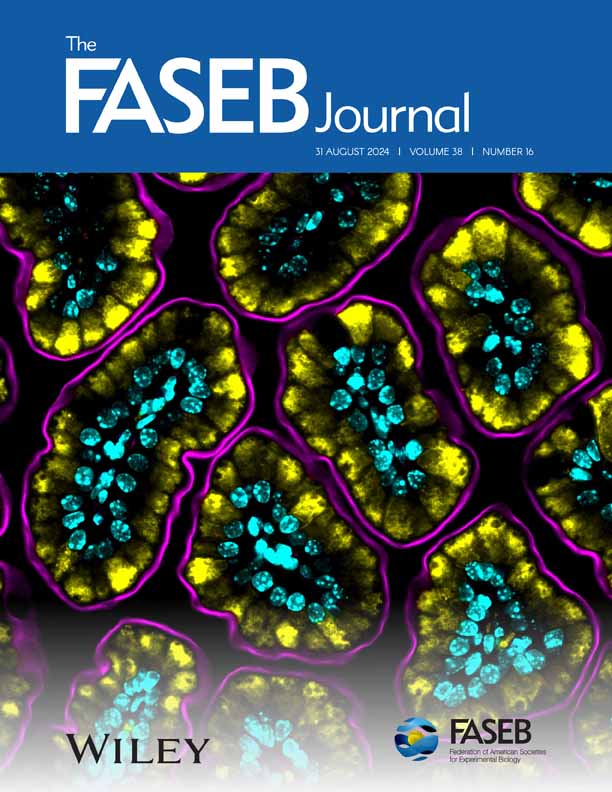Evaluation of His‐tag and immunoprecipitation procedures for recombinant protein purification
IF 4.2
2区 生物学
Q2 BIOCHEMISTRY & MOLECULAR BIOLOGY
引用次数: 0
Abstract
Histidine (His)‐tag is widely used for affinity purification of recombinant proteins, but the yield and purity of expressed proteins are quite different. Little information is available about quantitative evaluation of this procedure. The objective of current study was to evaluate His‐tag procedure quantitatively and to compare it with immunoprecipitation using radiolabeled tristetraprolin (TTP), a zinc finger protein with anti‐inflammatory property. Human embryonic kidney 293 cells were transfected with wild‐type and nine mutant plasmids with single or multiple phosphorylation site mutation(s) in His‐TTP. These proteins were expressed and mainly localized in the cytosol of transfected cells by immunocytochemistry and confocal microscopy. His‐TTP proteins were purified by Ni‐NTA beads with imidazole elution or precipitated by TTP antibodies from transfected cells after being labeled with [32P]‐orthophosphate. The results showed that 1) His‐tag purification was more effective than immunoprecipitation for TTP purification; 2) mutations in TTP increased the yield of His‐TTP by both purification procedures; and 3) mutations in TTP increased the binding affinity of mutant proteins for Ni‐NTA beads. These findings suggest that bioengineering phosphorylation sites in proteins can increase the production of recombinant proteins (Supported by NIH‐NIEHS and USDA‐ARS Intramural Research Programs).重组蛋白纯化的His - tag和免疫沉淀方法的评价
组氨酸(His)‐标签广泛用于重组蛋白的亲和纯化,但表达蛋白的产量和纯度存在较大差异。关于这一程序的定量评价资料很少。本研究的目的是定量评估His - tag方法,并将其与放射标记三戊三醇(TTP)免疫沉淀进行比较,TTP是一种具有抗炎特性的锌指蛋白。转染人胚胎肾293细胞的质粒为His‐TTP中单个或多个磷酸化位点突变的野生型质粒和9个突变质粒。通过免疫细胞化学和共聚焦显微镜观察,这些蛋白主要在转染细胞的胞浆中表达和定位。他的TTP蛋白用Ni - NTA珠用咪唑洗脱纯化,或者用[32P] -正磷酸盐标记后,用转染细胞的TTP抗体沉淀。结果表明:1)His‐tag纯化TTP比免疫沉淀纯化TTP更有效;2)两种纯化方法均能提高His‐TTP的产量;3) TTP的突变增加了突变蛋白对Ni - NTA珠的结合亲和力。这些发现表明,蛋白质中的生物工程磷酸化位点可以增加重组蛋白的产量(得到NIH‐NIEHS和USDA‐ARS校内研究计划的支持)。
本文章由计算机程序翻译,如有差异,请以英文原文为准。
求助全文
约1分钟内获得全文
求助全文
来源期刊

The FASEB Journal
生物-生化与分子生物学
CiteScore
9.20
自引率
2.10%
发文量
6243
审稿时长
3 months
期刊介绍:
The FASEB Journal publishes international, transdisciplinary research covering all fields of biology at every level of organization: atomic, molecular, cell, tissue, organ, organismic and population. While the journal strives to include research that cuts across the biological sciences, it also considers submissions that lie within one field, but may have implications for other fields as well. The journal seeks to publish basic and translational research, but also welcomes reports of pre-clinical and early clinical research. In addition to research, review, and hypothesis submissions, The FASEB Journal also seeks perspectives, commentaries, book reviews, and similar content related to the life sciences in its Up Front section.
 求助内容:
求助内容: 应助结果提醒方式:
应助结果提醒方式:


